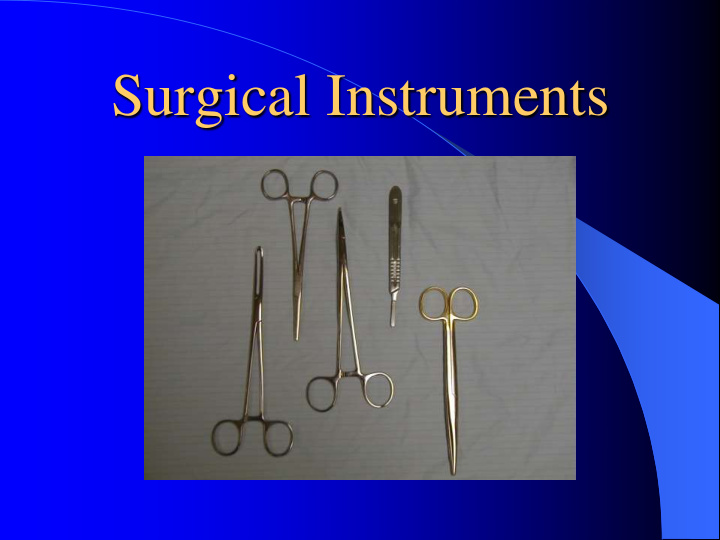



Surgical Instruments
Instruments Instruments are classified by their function – Cutting & Dissecting – Grasping & Holding – Clamping & Occluding – Exposing & Retracting – Suturing & Stapling – Viewing – Suctioning
Instruments – Dilating & Probing – Measuring – Microinstruments – Powered instruments
Cutting & Dissecting
Cutting & Dissecting Cutting instruments have sharp edges. They are used to dissect, incise, separate, or excise tissue. Most instrument sets will include #3 and #7 knife handles & suture, curved mayo, metz and tenotomy scissors.
Knife Handles Come in various #7 #4 #3 widths & lengths Blades are attached by slipping the slit in the blade into the groove on the handle
Knife Blades Blades with numeric prefix of “1” (e.g., 10, 11, 12, 15) fit #3 or #7 handles Blades with the numeric prefix “2” (e.g., 20, 21, 22, 23, 24) fit #4 handles
Knife Blades #10 are used for large skin incisions #15 are used for short shallow incisions #11 are used for initial skin puncture of tiny deep #15 #11 #10 incisions
Other Knife handles Long handles are used inside deep incisions (e.g., open abdominal cases) Beaver knifes are used for small delicate cases
Scissors Blades of scissors may be straight, angled, or curved Tips may be pointed or blunt, handles may be long or short Should be used only for their intended purpose
Straight Mayo (Suture) Scissors
Bandage/Dressing Scissors
Tissue/Dissecting Scissors
Curved Mayo Scissors
Metzenbaum Scissors
Tenotomy scissors
Iris Scissors
Other cutting Instruments
Ronguer
Osteotome
Curette
Freer Elevator
Rasp
Grasping & Holding
Grasping & Holding These instruments are used to grasp tissue and hold it in place without injuring surrounding tissues Forceps can be ringed or the thumbed variety
Grasping & Holding Most instrument sets will include kocher, allis, babcock, adson, tissue, debakey forceps, sponge sticks & towel clips.
Forceps
Kocher
Allis
Babcock
Sponge Stick
Towel Clip
Adsons
Tissue
Ferris Smith
DeBakey
Russians
Clamping & Occluding
Clamping & Occluding These instruments are used to apply pressure Some clamps are designed to crush the structure when applied Others are noncrushing and are used to occlude or secure tissue
Clamping & Occluding Most instrument sets will include mosquito, crile, kelly, tonsil, peon, and right angle clamps.
Anatomy of a Clamp
Mosquito
Crile
Kelly
Tonsil
Peon
mosquito crile kelly tonsil peon
Right Angle
Non-crushing Clamps
Bowel Clamp
Vascular Clamp
Bulldogs
Exposing and Retracting
Exposing and Retracting Used to pull Soft tissue and muscle aside to expose surgical site 2 types: – Hand held – Self retaining
Exposing and Retracting Most instrument sets will include small hand held , army-navy, malleable, weitlaner, and richardson retractors.
Hand Held Retractors
Skin Hooks
Senn
Cushing Vein Retractor
Volkman
Army-Navy
Malleable (Ribbon)
Richardson
Kelly
Harrington
Deaver
Self Retaining Retractors
Weitlaner
Cerebellar
Gelpi
Balfour
Bookwalter
Suturing and Stapling
Suturing and Stapling Needle holder sizes vary according to type of needle used Most instrument sets will have webster, crilewood, and mayo hegar type needle holders.
Suturing and Stapling Clip appliers place individual staples, available in reusable and disposable Disposable staplers
Needle Holders
Webster
Crilewood
Mayo Hegar
Castroviejo
Skin Stapler
Weck Hemoclip Applier
Ligaclip Applier
Staplers
Viewing
Viewing Surgeons can examine body cavities, hallow organs, or structures with viewing instruments Procedures may be performed through them
Nasal Speculum
Vaginal Speculums
Rectal Speculums
Rigid Endoscope
Laparoscopic Trocars
Laparoscopic Instruments
Thorascopic Trocars
Arthroscopy Cannulas
Cystoscopy Sheath
Recommend
More recommend